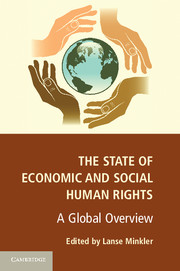Book contents
- Frontmatter
- Contents
- Contributors
- Acknowledgments
- 1 Introduction: Why Economic and Social Human Rights?
- I CORE RIGHTS
- II NONDISCRIMINATION
- 7 The Rights of the Child to an Adequate Standard of Living: Applying International Standards to the U.S. Case
- 8 Achieving Women's Economic Rights, in Policy and in Practice
- 9 Statelessness and Economic and Social Rights
- III META
- Index
- References
9 - Statelessness and Economic and Social Rights
Published online by Cambridge University Press: 05 February 2013
- Frontmatter
- Contents
- Contributors
- Acknowledgments
- 1 Introduction: Why Economic and Social Human Rights?
- I CORE RIGHTS
- II NONDISCRIMINATION
- 7 The Rights of the Child to an Adequate Standard of Living: Applying International Standards to the U.S. Case
- 8 Achieving Women's Economic Rights, in Policy and in Practice
- 9 Statelessness and Economic and Social Rights
- III META
- Index
- References
Summary
Introduction
We live in a world where millions of people acquire citizenship automatically each year through jus soli (birth on the territory), jus sanguinis (citizenship via descent), and other state-approved channels of citizenship acquisition. We also live in a world where an estimated 12 to 15 million people lack citizenship altogether (Southwick and Lynch 2009; Manly 2007; see Figure 9.1). These stateless people are “not considered…national[s] by any State under the operation of its law” (UN 1954, Article 1). Statelessness is often described as a condition of invisibility and heightened vulnerability. Without citizenship from anywhere, the stateless are susceptible to myriad human rights violations from: indefinite or unnecessary detention, torture, and enslavement to family separation, the refusal of identity documents, and inadequate housing and health care, among others.
Unlike the highly developed international protection regime that exists for refugees, and the protection extended in international law by states to their own citizens, stateless people are without recourse to such protection. They are outcasts in an international system of states that requires each person to be a citizen of somewhere (League of Nations 1930). In contrast to refugees or internally displaced persons (IDPs), stateless persons “lack the assistance, benefits or attention of government or humanitarian communities” (Cordell 2011). They are thus “perhaps even more vulnerable than refugees due to their near-total lack of ability to exercise their human rights” (Glickman 2010). Their lack of formal membership in any state translates into violations of their economic, social, cultural, civil, and political rights, as well. Despite the multitude of human rights violations that often attach to the condition of being stateless, statelessness has yet to garner the attention given by practitioners and the international community to other groups of concern, such as migrants, refugees, and IDPs. Statelessness continues to be a “blind spot” on the international community's agenda (Lynch 2009) and, until recently, the United Nations High Commissioner for Refugees (UNHCR) – the body mandated with the identification and protection of the stateless – admitted that it was not doing enough to address this issue (UNHCR 2007).
- Type
- Chapter
- Information
- The State of Economic and Social Human RightsA Global Overview, pp. 221 - 248Publisher: Cambridge University PressPrint publication year: 2013
References
- 2
- Cited by

